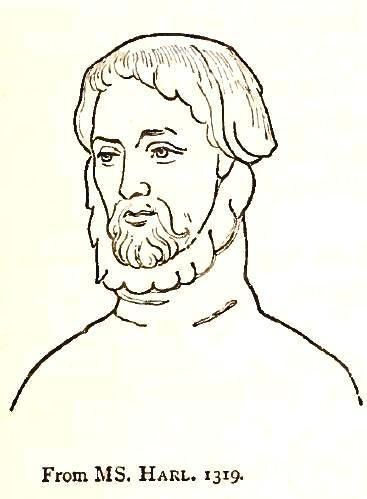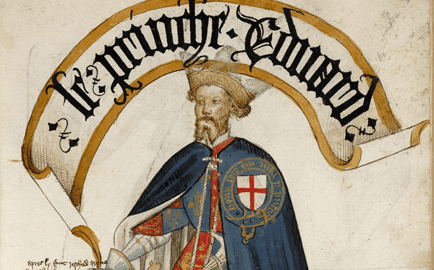Successor Edward of Norwich Name Edmund Langley, | ||
 | ||
Died August 1, 1402, Hertfordshire, United Kingdom Children Edward of Norwich, 2nd Duke of York Parents Edward III of England, Philippa of Hainault Siblings John of Gaunt, Edward, the Black Prince Similar People Edward III of England, John of Gaunt, Edward of Norwich - 2nd Duke, Richard of Conisburgh - 3rd Earl o, Richard of York - 3rd Duke of Y | ||
Edmund of Langley, 1st Duke of York
Edmund of Langley, 1st Duke of York, KG (5 June 1341 – 1 August 1402) was the fourth surviving son of King Edward III of England and Philippa of Hainault. Like many medieval English princes, Edmund gained his nickname from his birthplace: Kings Langley Palace in Hertfordshire. He was the founder of the House of York, but it was through the marriage of his younger son, Richard of Conisburgh, 3rd Earl of Cambridge, to Anne de Mortimer, great-granddaughter of Edmund's elder brother Lionel of Antwerp, 1st Duke of Clarence, that the House of York made its claim to the English throne in the Wars of the Roses. The other party in the Wars of the Roses, the incumbent House of Lancaster, was formed from descendants of Edmund's elder brother John of Gaunt, 1st Duke of Lancaster, Edward III's third son.
Contents
- Edmund of Langley 1st Duke of York
- Early years
- Military career
- Later life
- Marriage
- Shakespeares Duke of York
- References

Early years

On the death of his godfather, the Earl of Surrey, Edmund was granted the earl's lands north of the Trent, primarily in Yorkshire. In 1359, he joined his father King Edward III on an unsuccessful military expedition to France and was made a knight of the Garter in 1361. In 1362, at the age of twenty-one, he was created Earl of Cambridge by his father.
Military career

Edmund took part in several military expeditions to France in the 1370s. In 1369, he brought a retinue of 400 men-at-arms and 400 archers to serve with John Hastings, 2nd Earl of Pembroke, on campaigns in Brittany and Angouleme. The following year, he first joined Pembroke again on an expedition to relieve the fortress of Belle Perche and then accompanied his eldest brother Edward, the Black Prince, on a campaign that resulted in the siege and sack of Limoges. In 1375, he sailed with the Earl of March to relieve Brest, but after some initial success, a truce was declared.
In the 1370s, English envoys entered into an alliance with Fernando I of Portugal, where Portugal promised to attack Castille with the Lancasterian army. As a consequence of The Caroline War in France, the Duke of Lancaster was forced to postpone the invasion of Castille. In 1381, Edmund finally led an abortive expedition to press The Duke of Lancaster's claim to the Castile, joining with King Ferdinand of Portugal in attacking Castile as part of the Fernandine Wars. After months of indecisiveness, a peace was again declared between Castile and Portugal, and Edmund had to lead his malcontented troops home.
Edmund was appointed Constable of Dover Castle and Warden of the Cinque Ports on 12 June 1376 and held office until 1381. He acted as Keeper of the Realm in 1394/95 when his nephew, King Richard II of England, campaigned in Ireland and presided over Parliament in 1395. He was also keeper of the realm in 1396 during the king's brief visit to France to collect his child-bride Isabella of Valois. The duke was left as Custodian of the Realm in the summer of 1399 when Richard II departed for another extended campaign in Ireland. In late June of that year, the exiled Henry Bolingbroke landed at Bridlington in Yorkshire. He raised an army to resist Bolingbroke, then decided instead to join him, for which he was well rewarded. He thereafter remained loyal to the new Lancastrian regime as Bolingbroke overthrew Richard II to become King Henry IV.
Later life
On 6 August 1385, Edmund was elevated to Duke of York.
In Richard II's will, Edmund was highly emphasised as the king's heir despite the stronger claims of Henry of Bolingbroke and Edmund Mortimer. This was not due to any preference Richard had for Edmund, but rather a desire the king had to set Edmund's son, Edward, on the throne. Towards the end of his life, in 1399, he was appointed Warden of the West March for a short period.
Edmund of Langley died in his birthplace and was buried there in the church of the mendicant friars. His dukedom passed to his eldest son, Edward.
Marriage
Langley's first wife, Isabella, was a daughter of King Peter of Castile and María de Padilla. She was also the sister of the Infanta Constance of Castile, the second wife of Langley's brother John of Gaunt. They had two sons and a daughter:
After Isabella's death in 1392, Langley married his cousin Joan Holland, whose great-grandfather Edmund of Woodstock, 1st Earl of Kent, was the half-brother of Langley's grandfather Edward II; she and Langley were thus both descended from King Edward I. The marriage produced no children.
Shakespeare's Duke of York
Edmund, the 1st Duke of York, is a major character in Shakespeare's Richard II. In the play, Edmund resigns his position as an adviser to his nephew Richard II, but is reluctant to betray the king. He eventually agrees to side with Henry Bolingbroke to help him regain the lands Richard confiscated after the death of Bolingbroke's father, John of Gaunt. After Bolingbroke deposes Richard and is crowned Henry IV, Edmund discovers a plot by his son Aumerle to assassinate the new king. Edmund exposes the plot, but his wife Isabella convinces Henry to pardon her son.
